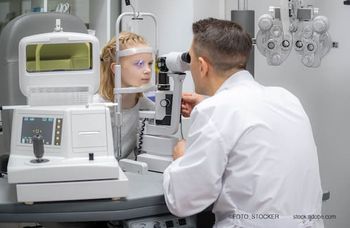
Clues differentiate ischemic optic neuropathy, optic neuritis
Minneapolis-Differentiating ischemic optic neuropathy from optic neuritis can be problematic. The type of visual field defect, the presence or absence of pain, radiologic differences distinguishing between the two, and the degree of visual recovery, among others, may be helpful clues, Howard D. Pomeranz, MD, PhD, suggested.
Minneapolis-Differentiating ischemic optic neuropathy from optic neuritis can be problematic. The type of visual field defect, the presence or absence of pain, radiologic differences distinguishing between the two, and the degree of visual recovery, among others, may be helpful clues, Howard D. Pomeranz, MD, PhD, suggested.
"Ischemic optic neuropathy is often associated with the 'disc at risk,' or the small cup-to-disc ratio, whereas optic neuritis is not typically associated with this type of optic disc anatomy and might help differentiate between the two entities," explained Dr. Pomeranz, director, Neuro-Ophthalmology Service, and assistant professor of ophthalmology, neurology, and neurosurgery at the University of Minnesota, Minneapolis.
"Optic neuritis is an inflammatory form of optic nerve disease and can be associated with several systemic diseases, such as multiple sclerosis, whereas ischemic optic neuropathy is a vascular form of optic nerve disease and is associated with risk factors such as hypertension, diabetes, thrombotic disorders, and hypercholesterolemia," he continued.
Dr. Pomeranz also underscored the importance of following patients over time.
"Typically, a larger percentage of patients with optic neuritis recover vision, whereas a small percentage of those with ischemic optic neuropathy will do so," he pointed out.
Radiology resultsThe results of another study by Dr. Rizzo suggest that perhaps radiology results can help physicians distinguish between the two diseases. In that study, the magnetic resonance imaging (MRI) characteristics of acute optic neuritis were compared with those of ischemic optic neuropathy. It was reported that almost all patients with optic neuritis had abnormal gadolinium enhancement and T1 signal abnormalities in the affected optic nerve. However, only five of the 32 patients with ischemic optic neuropathy had an MRI abnormality.
An ultrasonographic study performed in 1997 by Gehling found that in patients with optic neuritis, the diameter of the optic nerve appeared to be increased whether or not there was optic disc swelling, but in ischemic optic neuropathy, the diameter of the optic nerve was usually normal.
Dr. Pomeranz also recommended looking at the disc to discover telltale characteristics that would be useful diagnostic clues. Judith Warner, MD, and colleagues reported that patients with altitudinal-type swelling of the optic disc, disc pallor, arterial attenuation, or hemorrhage were more likely to have ischemic optic neuropathy than optic neuritis.
"There are a number of similarities between the optic neuritis and ischemic optic neuropathy. Both present with vision loss, visual field defects, an afferent pupillary defect, and color vision defects. Both can also progress over the same period of time," he said. "There are differences, however, in that patients with pain upon palpation or eye movement usually have optic neuritis compared with a very small number of patients with ischemic optic neuropathy."
In addition with anterior ischemic optic neuropathy, the optic nerve is always swollen; with optic neuritis most patients have retrobulbar optic neuritis, but about one-third can have swelling of the optic disc. Patients with nerve fiber layer hemorrhages associated with the disc swelling are more likely to have ischemic optic neuropathy. Patients with ischemic optic neuropathy can have both eyes involved, either simultaneously or sequentially, which does not occur commonly in adults with optic neuritis.
The degree of visual recovery is also a helpful clue, in that optic neuritis is typically associated with substantial visual recovery and with anterior ischemic optic neuropathy that is not common, Dr. Pomeranz explained.OT
Newsletter
Don’t miss out—get Ophthalmology Times updates on the latest clinical advancements and expert interviews, straight to your inbox.



















































.png)


